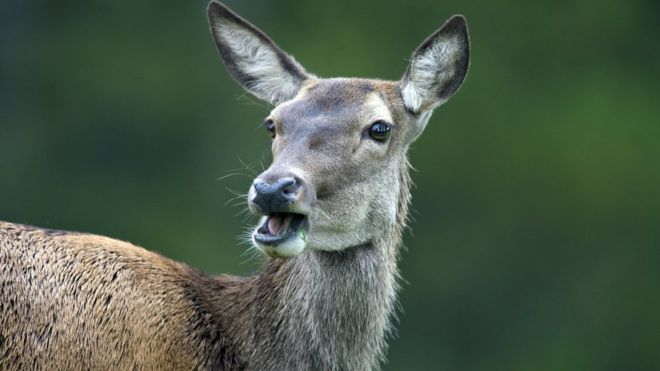
For more than 40 years people believed the elusive Bactrian deer was extinct in Afghanistan, unsurprising considering the conflict across the country in that time.
But then, unexpectedly, in 2013, ecologist Zalmai Moheb and a team of researchers caught a glimpse of one.
Their findings were recently published and the IUCN, the world conservation union and keeper of the Red List of endangered species, is also now considering reclassifying the deer, a move that would highlight just how vulnerable the animal still is.
It was an extraordinary moment for Mr Moheb and one that tells a story – not just about the animal and how it managed to survive against the odds – but the country too.
“We said to ourselves, ‘wow, we are going to confirm the presence of this rare deer for this first time in 45 years when conservationists had almost lost hope to find this animal again in Afghanistan””, he said.
The Bactrian deer, also called the Bukhara, is a rare sub-species of red deer, native to central Asia. They are typically found in riparian habitats- areas where trees, shrubs and grasses grow along river banks.The deer was almost feared lost in the 1970s, when researchers claimed that only 120 remained in a small pocket of north-eastern Afghanistan, in the Takhar province, on the border of Tajikistan.
Later that decade, in 1979, the Soviet Union invaded Afghanistan, heralding a war that lasted nine years and unleashing chaos which saw hundreds of thousands killed and millions flee the country. A devastating civil war followed the Soviet invasion and then the Taliban installed themselves in 1996 until they were ousted by a US-led invasion in 2001.
The country has since then maintained democracy, albeit with militants still active and dominant in certain regions and security in some parts by no means guaranteed.
“We were not very confident at the beginning, but we continued the search nevertheless,” Mr Moheb, a PhD student at the University of Massachusetts Amherst and wildlife ecologist with the Wildlife Conservation Society, said as he described his mission.
He led a small team trying to find a trace of the deer in the north, in an area ostensibly at peace but with some security concerns.
“Eventually we found one, which was very exciting,” he said.
It was hoof marks and faecal pellets that led Moheb and his team to believe that the Bactrian deer could still exist.
“Finding field evidence gave us hope that the species still existed in the area,” said Mr Moheb, who came across the young female deer in the Darqad district, along the border with Tajikistan.
Challenges in conservation
They didn’t go in with much optimism, knowing that the violence that swept through the nation for more two decades was bound to have had an impact on the wildlife.
“Conflicts have always been detrimental, not only to a wild species, but for the entire ecosystem,” said Mr Moheb. “Hunting for food, habitat degradation and deforestation were all things that affected the Bactrian.”
In addition, access to firearms meant anyone could easily shoot down animals – and the deer population suffered as a result.
A number of the Bactrian deer, the exact figure of which is unknown, are believed to have migrated to Tajikistan during the war, enabling them to escape the crossfire in Afghanistan at the time.
Mr Moheb believes that this is how many of the deer managed to survive.
However, guns aren’t the only things putting the Bactrian at risk today.
According to Mr Moheb, wealthy families are believed to keep the rare animal as pets, only one of many obstacles the animal has had to overcome.
Conducting research in an area that has seen violence has also proved a challenge at times and Mr Moheb says entering the region was a “concern”.
“We take every precaution to minimise the risks for us and our colleagues”, he said. “Working in this field is sometimes challenging, but always interesting.”
But his find is a boost for the conservation community.
The global population of the deer has increased from around 300 in the 1960s to around 1,900 in 2011, partly as a result of conservation efforts.
However, under the IUCN’s Red list, which keeps track of animals under threat, the Bactrian deer was until recently classified as a subspecies of the red deer- an animal that is listed under a “least concern conservation status”.
The Bactrian is now being merged with two other former Red deer subspecies to better reflect its endangered status, with the categorisation of this new species still facing “assessment”, according to Craig Hilton-Taylor, head of the list.
“The assessment of this new species is in the process of being finalised for publication in December”, said Mr Hilton-Taylor.
Today, governmental organisations and NGOs are working together to conserve wildlife through different parts of Afghanistan, employing wildlife rangers and promoting law enforcement in the area.
The Bactrian deer is also native to the surrounding areas of Kazakhstan, Tajikistan, Turkmenistan and Uzbekistan.
“The presence of the Bactrian deer is very important for Afghanistan,” he said, adding that it was part of the nation’s natural heritage.
“Despite all the challenges in conservation, you can feel the good you’re doing for humanity”.
[Source:-BBC]



